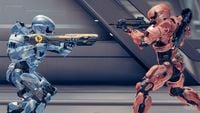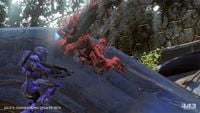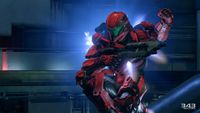MJOLNIR Powered Assault Armor (GEN2): Difference between revisions
From Halopedia, the Halo wiki
No edit summary |
|||
| Line 10: | Line 10: | ||
While the suit's primary production model bears less significance than in the previous Mjolnir generations due to GEN2's more distributed design philosophy, the Materials Group's [[MJOLNIR Powered Assault Armor/Warrior|Warrior]] variant is officially considered the mainline model of the GEN2 armor. Another prevalent model is the [[MJOLNIR Powered Assault Armor/Recruit|Recruit]] variant, which is issued to all Spartan-IVs upon induction.<ref>'''Halo 4''', ''Spartan Armor menu descriptions''</ref> | While the suit's primary production model bears less significance than in the previous Mjolnir generations due to GEN2's more distributed design philosophy, the Materials Group's [[MJOLNIR Powered Assault Armor/Warrior|Warrior]] variant is officially considered the mainline model of the GEN2 armor. Another prevalent model is the [[MJOLNIR Powered Assault Armor/Recruit|Recruit]] variant, which is issued to all Spartan-IVs upon induction.<ref>'''Halo 4''', ''Spartan Armor menu descriptions''</ref> | ||
As of 2558, GEN2 armor is standard-issue for all active Spartans, including Spartan-IIIs and [[Blue Team]]. | |||
==Armor variants and upgrades== | ==Armor variants and upgrades== | ||
Revision as of 06:28, November 23, 2015

The MJOLNIR Powered Assault Armor [GEN2] is the second system-wide generation of the MJOLNIR Powered Assault Armor. GEN2 introduces many improvements to the suit's core architecture, specifically tailored for use by the Spartan-IV supersoldiers.[1][2][3]
Background
GEN2 was developed by the Materials Group as a response to the SPARTAN-IV project. The armor was designed to compensate for the Spartan-IVs' less extensive physical augmentations in comparison to the previous two generations. As a result, the armor multiplies the strength of its wearer significantly more than the first-generation suits, granting the Spartan-IVs roughly equal strength as their GEN1-equipped predecessors while wearing the suit.[3][4] The GEN2 suit is also lighter and stronger in construction than the first-generation Mjolnir line,[3][1][2] weighing approximately 200 kilograms.[5]
The GEN2 armor incorporates new ad hoc modification systems which allow the armor to use armor abilities, tactical packages, and support upgrades. GEN2 is produced by at least seven manufacturers, both within the military and among private contractors. Production of some GEN1 variants was shifted between corporate entities, while other contracts were transferred from the military to private industries.[1] Like its GEN1 predecessors it is backwards compatible (through hardware and firmware upgrades) with previous armor systems, including the Mark V, the Mark VI, and the MJOLNIR variant of the ODST armor.[6]
While the suit's primary production model bears less significance than in the previous Mjolnir generations due to GEN2's more distributed design philosophy, the Materials Group's Warrior variant is officially considered the mainline model of the GEN2 armor. Another prevalent model is the Recruit variant, which is issued to all Spartan-IVs upon induction.[7]
As of 2558, GEN2 armor is standard-issue for all active Spartans, including Spartan-IIIs and Blue Team.
Armor variants and upgrades
|
|
Attachments
The armor system is built to support a variety of attachments and equipment which allow it to utilize armor abilities. Some of them have been reverse-engineered from Covenant and Forerunner technology.
- Airstrike - Calls in heavy munitions around the user
- M2705 regeneration field - Applies a force to remove hostiles from the presence of the user and then temporarily appropriates armor system functions, targeting biological and combat vitality-oriented armor functions in order to heal the user and repair the armor
- M805X thruster pack - A booster pack used to propel the wearer forward or to either side
- Overshield - A Covenant-developed technology that strengthens the user's energy shielding system
- Proximity mines - Deploys three mines that lock onto hostiles
- Repel - Flash-freezes a small area, causing considerable harm to nearby personnel and equipment
- Seeker drone - An explosive homing drone
- Series 12 jetpack - Mitigates gravity, allowing mobility over challenging terrain
- Shock chain - Creates an energy shield that damages enemies and restores the user's energy shielding
- Stun blast - Creates a short-range electromagnetic pulse (EMP) which interferes with all electronic equipment within the radius of the pulse
- Teleport - Allows near-instantaneous transport over short distances
- Type-27 hologram - Creates a holographic projection of the user that can draw enemy fire
- Type-3 active camouflage - Affords the wearer a brief period of near-invisibility in addition to scrambling nearby motion detectors
- Z-2500 autosentry - A Forerunner-created support drone used to suppress enemy combatants
- Z-4190 bubble shield - A stationary shield reverse-engineered from Forerunner technology
- Z-5080 Promethean vision - A sonar-like Forerunner visual enhancement system that displays movement through solid objects
- Z-90 hardlight shield - A shield made from hard light reverse-engineered from Forerunner technology
Armor components
- Biofoam injectors: Allow for physical injuries to be sealed and repaired without the use of external medkits
- Energy shielding: A protective barrier that surrounds the armor and protects the user from harm
- Inner skinsuit: The inner skinsuit is made of a moisture-absorbing synthetic material linked to an environmental control computer and the occupant's neural interface. It controls the suit's temperature and actively changes how the suit fits the user.[11]
- Compact fusion reactor: The fusion reactor is the most essential part of the MJOLNIR system, as it provides power to all equipment on the MJOLNIR armor - the reactor is built into the suit and allows for nearly unlimited movement. [GEN2]'s fusion reactor is installed at the back of the torso carapace.[12]
- Magnetic weapon holder strips: The MJOLNIR armor features very small, yet powerful magnets placed on the legs, waist, and back of the suit that are used to hold any equipment or any weapons with a magnetic property. The suit also contains a magnet system within its boots that allows its wearer to stay attached to a metal surface in zero G environments and can be toggled on or off by the wearer.
- Power supply control unit: Manages the power supply of the armor
- MJOLNIR GEN2 BIOS: The basic input/output system, standard firmware interface of the GEN2 suite
- VISR 4.0: Up to version 4.09, these visor installments are optimized and customized to facilitate specialized tasks.[13]
- Force-multiplying circuits: Allows the user greatly enhanced reflexes and strength, improving mobility and combat effectiveness in close quarters
- Motion tracker: Shows movement of friendly and enemy units within the system's radius
- Pressure seal: The pressure seal is a vital component to the MJOLNIR system, it keeps the system airtight, underwater or in space. The seal is very strong and will only break under extreme pressure, such as in a high velocity impact or when the hydrostatic gel has been over pressurized.
- Support upgrades: These customized and specialized upgrades allow combat advantages by modifying the core and periphery systems of GEN2.
- Sprint module: Unlike previous armor systems, Mjolnir GEN2 has a built-in sprint module that allows the user to run at faster speeds by overriding safety protocols.[1] It is functionally similar to the version developed by Kat-B320 of NOBLE Team, which saw widespread deployment across Reach in the planet's final days.[14]
- Tactical packages: These customized and specialized packages allow combat advantages by modifying the core and periphery systems of GEN2.
- Titanium nanocomposite bodysuit: Sandwiched between the external armor and the internal padding is a thick armored bodysuit. The bodysuit is made of a nonrigid titanium-based material, making it very strong and yet very flexible. The suit has numerous functions, small but vital to the safety and survival of the wearer. It also serves as another layer of protection against ballistics attacks and is coated with a heat-resistant material to disperse heat from plasma weapons. Many components of the GEN2's titanium bodysuit are conspicuously fashioned after the shape of human musculature; this was less prominent in previous Mjolnir generations. Some models have portions of the bodysuit share their color with the external armor plating, though completely black bodysuits are still common.[15][16]
- Integrated thruster system: GEN2 suits are equipped with an array of shoulder- and back-mounted thrusters, increasing a Spartan's mobility in the field and presumably in vacuum environments.[17] The system, which was added as part of a series-wide update, partly alleviates the need to use an external thruster unit or jetpack; however, it provides only limited thrust and as such does not fully replace external thrust apparatuses.[18] It is still powerful enough to allow the user to hover a few seconds in mid-air when activated in a stabilizing arrangement. Integrated thrusters saw use in combat as early as March 2555.[19]
- Auto-repair and bypass nodes: Any damage that the armor plating suffers can be repaired by built-in, triply-redundant subsystems. These systems are receptive to nanomachines facilitating the repair.[20] Additionally, bypass channels allow certain components to function if routing is compromised by extensive damage. Both these systems can fail, resulting in "scarred" armor plating.[21]
Trivia
- The way the GEN2 armor is equipped by UNSC Infinity's dedicated machinery onto its wearer is reminiscent of Iron Man armor in the Marvel Cinematic Universe and Tychus Findlay's CMC powered armor in Starcraft II.
- All non-essential Spartan-IV NPCs in Halo 4 wear the full Recruit armor set and visor color. Steel serves as their suits' primary color and gold is the secondary color.
- Spartan Tedra Grant field tested several early [GEN2] models.[22]
Gallery
Fireteam Majestic wearing [GEN2] undersuits
Shields flaring on two [GEN2] suits during the Requiem Campaign
A red Air Assault-clad Spartan-IV attacking a blue Recruit-clad Spartan-IV with a ground pound during a War Games match on Regret.
List of appearances
- Halo: Glasslands (First appearance)
- Halo: The Thursday War
- Halo 4 (First identified as GEN2)
- Halo: Spartan Assault
- Halo: Initiation
- Halo: Escalation
- Halo 2 Anniversary
- Halo: New Blood
- Hunt the Truth
- Halo: Spartan Strike
- Halo: Hunters in the Dark
- Halo 5: Guardians
- Halo Online
Note
- ^ To avoid unnecessary clutter caused by redundant citations, all subsequent entries are cited using the Halo 4, Halo 5: Guardians, and Halo Online Spartan Armor menus.
Sources
- ^ a b c d Halo 4: ORDNANCE + ARMOR
- ^ a b Game Informer: May 2012
- ^ a b c Frank O'Connor interview during San Diego Comic-Con 2012 1:15 - 2:10
- ^ Halo 5: Guardians – Unmasking The Fireteam Hunting Master Chief
- ^ Halo: New Blood, page 157 (Google Play edition)
- ^ a b c Rooster Teeth Expo 2013
- ^ Halo 4, Spartan Armor menu descriptions
- ^ a b c Halo 4 Limited Edition Contents
- ^ a b c d e f g : The Halo Bulletin 8.15.12
- ^ : The Halo Bulletin 7.25.12
- ^ Halo: The Fall of Reach, page 71, (2001 edition) page 81, (definitive edition) page 90 (2010 edition)
- ^ The Halo Bulletin 9.24.14
- ^ Halo 4 - All 17 Visor Colors, Master Chief Helmet & Griffball!
- ^ Halo: Reach game manual
- ^ Halo 4
- ^ Halo 5: Guardians
- ^ YouTube: Halo 5: Guardians Multiplayer Beta: Behind the Scenes
- ^ Halo Waypoint: UNSC Jet Pack
- ^ Halo: Hunters in the Dark page 292
- ^ YouTube: The Science Behind The Halo Series
- ^ Halo 5: Guardians Multiplayer Beta - Scarred Mjolnir Mark VI description
- ^ Halo 4: The Essential Visual Guide
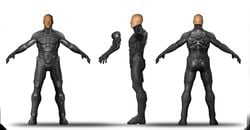
![Concept art of the Mjolnir [GEN2] skinsuit for male wearers](https://halo.wiki.gallery/images/thumb/b/b0/H4-Concept-Undersuit-Male.jpg/160px-H4-Concept-Undersuit-Male.jpg)
![Concept art of the female [GEN2] skinsuit](https://halo.wiki.gallery/images/thumb/2/21/H4-Concept-Undersuit-Female.jpg/80px-H4-Concept-Undersuit-Female.jpg)
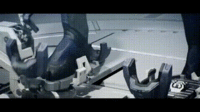

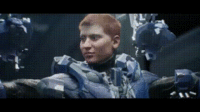
![The HUD of the [GEN2] armor.](https://halo.wiki.gallery/images/thumb/4/4d/H4-Selecting_Ordnance_Speed_02.jpg/200px-H4-Selecting_Ordnance_Speed_02.jpg)

![Fireteam Majestic wearing [GEN2] undersuits](https://halo.wiki.gallery/images/thumb/b/b4/H4_SOS1E1_Spartan_IV_Hologram.jpg/200px-H4_SOS1E1_Spartan_IV_Hologram.jpg)

![Fireteam Majestic in their [GEN2] armor](https://halo.wiki.gallery/images/thumb/2/2b/Majestic_-_2.png/200px-Majestic_-_2.png)
![Shields flaring on two [GEN2] suits during the Requiem Campaign](https://halo.wiki.gallery/images/thumb/4/47/H4-SpartanOps-WatcherCrawler.jpg/200px-H4-SpartanOps-WatcherCrawler.jpg)
